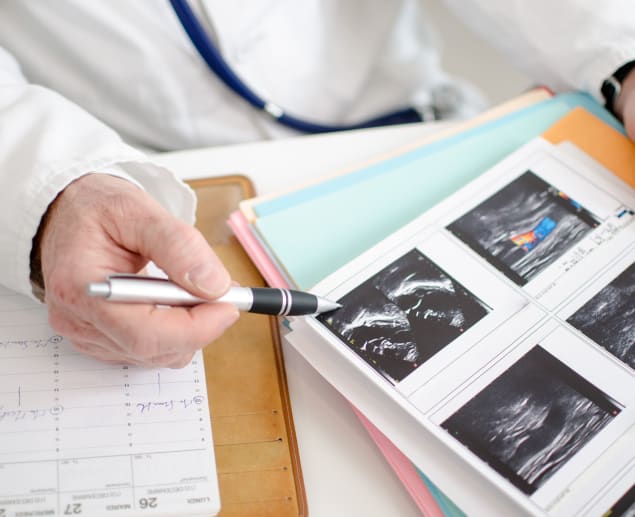💡 Learn more about how ultrasound scans work
Types of diagnostic ultrasound scans
External ultrasound scans
- Diagnostic external ultrasound scans are most commonly used to examine the heart, breasts and abdominal organs that can be assessed through the skin. This also includes the liver, kidneys, spleen, and pancreas.
- Organs that contain air, such as the stomach and bowels, are not generally suited to external ultrasound scans as the air prevents soundwaves from bouncing off the structures to create an image.
- Echocardiograms are a type of external ultrasound used to diagnose and monitor certain heart conditions. A transthoracic echocardiogram (TTE) scans the heart and surrounding blood vessels by running the ultrasound probe across the chest. TTEs can help detect damage from a heart attack, heart failure, heart disease, problems with heart valves including infection (endocarditis), and thickened/enlarged heart walls (cardiomyopathy).
Internal ultrasound scans
- Transvaginal ultrasounds (TVS) are a type of internal ultrasound scan that examine female reproductive organs (e.g. cervix, fallopian tubes, ovaries, uterus) by inserting an ultrasound wand inside the vaginal canal. TVS are used to investigate and diagnose issues associated with pelvic pain, abnormal cervical screening results, cysts and fibroids, and infertility. Possible diagnoses could include pelvic infection, polycystic ovary syndrome (PCOS), miscarriage, ectopic pregnancy and certain types of cancer.
- Transrectal ultrasounds (TRUS) are another form of internal ultrasound most often used to scan the prostate gland, and look for abnormalities in the rectum and other nearby structures. Similar to a TVS, a probe is inserted internally via the rectum to gain a clear view of the prostate, assess its size, any abnormalities, and can be used to diagnose cancer or BPH (benign prostatic hyperplasia).
Endoscopic ultrasound scans
- Endoscopic ultrasounds (EUS) are used to examine areas such as the stomach, throat, oesophagus and lungs. EUS can help investigate sources of abdominal and chest pain, and can help evaluate and diagnose certain types of cancer, Barrett's oesophagus, bile duct stones and pancreatitis.
- Some echocardiograms (scans of the heart) are also carried out via a small probe passed down the throat into the stomach, to gain a view of the heart from internally. These are called transoesophageal echocardiograms (TOE), and they prevent the lungs and ribs from obscuring the images of the heart. TOEs can be used to plan heart surgery, check on the health of heart valves and chambers, and look for issues such as valve disease and congenital heart disease.
Doppler ultrasound scans
- Rather than scanning tissues or organs within the body to create images, Doppler ultrasounds estimate the blood flow through the blood vessels. In this type of scan, the high-frequency sound waves bounce off of the red blood cells that move through your circulatory system, and the changes in frequency are measured and displayed on a graph.
- Doppler ultrasounds are external scans, and the transducer probe is held against the skin over the area of concern. They are a non-invasive alternative to angiography (injecting dye into the blood vessels before an X-ray).
- Diagnoses that can be confirmed with Doppler ultrasounds include blood clots, blocked arteries (occlusion), aneurysms, narrowing of an artery (stenosis), and poorly functioning valves.
Whatever pain or concern you are facing, an ultrasound scan is a reliable method for assessing and diagnosing issues within the soft tissues, musculoskeletal system and vascular system without harmful radiation exposure. Book a private ultrasound to avoid long waiting lists, and get the peace of mind you need as soon as possible.
- Book your ultrasound scan direct with us, without referral from your GP. Our expert clinicians will provide a speedy referral and fast results, with no waiting lists.
https://www.betterhealth.vic.gov.au/health/conditionsandtreatments/ultrasound-scan#bhc-content
https://my.clevelandclinic.org/health/articles/12254-musculoskeletal-system-normal-structure--function#:~:text=
https://www.independentimaging.com/abcs-imaging-difference-xray-ultrasound-mri-ct-scan/
https://www.healthline.com/health/transvaginal-ultrasound#results
https://www.nhs.uk/conditions/echocardiogram/
https://www.mayoclinic.org/tests-procedures/endoscopic-ultrasound/about/pac-20385171
https://my.clevelandclinic.org/health/diagnostics/4992-echocardiogram-transesophageal-tee
https://www.mayoclinic.org/doppler-ultrasound/expert-answers/faq-20058452
https://medlineplus.gov/lab-tests/doppler-ultrasound/
https://www.cancer.gov/publications/dictionaries/cancer-terms/def/transrectal-ultrasound
https://www.radiologyinfo.org/en/info/us-prostate






